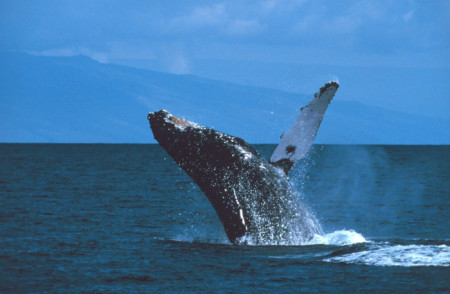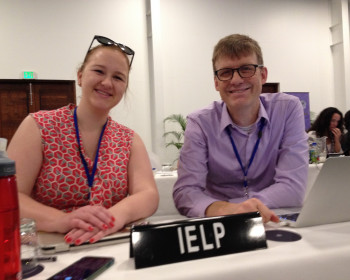Whaling and the International Whaling Commission
Open gallery

IELP has been helping the International Whaling Commission (IWC) find its way in the modern era of environmental law. IELP has prepared two detailed comparative assessments of compliance regimes within international and regional fisheries organizations to provide a basis for the adoption of new regulations for the resumption of commercial whaling. IELP has also prepared a review of methods for assessing financial contributions. On behalf of several organizations that oppose Japan’s scientific whaling, IELP prepared a Pelly Petition to impose sanctions against Japan for diminishing the effectiveness of the Convention on International Trade in Endangered Species of Wild Fauna and Flora (CITES) and the rules of the IWC. In addition, IELP members have participated in the last three annual meetings of the IWC, including in 2001 when Prof. Chris Wold attend as the legal advisor to the United Kingdom.
Fisheries Compliance Regimes
The IWC has been discussing the resumption of whaling ever since it made its 1982 decision to impose a moratorium on commercial whaling starting with the 1985/1986 whaling season. Originally, the IWC thought that only a statistical model—the Revised Management Plan (RMP)—was needed to process population data and historical catch data, in order to calculate a sustainable harvest quota. Very quickly, however, the IWC recognized that more was needed to ensure a legal and sustainable harvest. As a result, it called for the creation of a Revised Management Scheme (RMS), which would incorporate the RMP. According to IWC documents, the RMS will include, among other things, “an effective inspection and observation scheme which fully addresses inter alia the issues of under-reporting and mis-reporting of catches.”
The IWC members, however, have not agreed on what should be included in an “effective inspection and observation scheme” and which other mechanisms should be included in an RMS to ensure whales are harvested legally and sustainably. Some countries, including the United States, Australia, and New Zealand, among others, believe that an effective inspection and observation scheme would need to include:
- 100% observer coverage on all boats;
- registration of all whaling vessels with the IWC;
- 24-hour vessel monitoring of position and catch; and
- DNA testing of all whales caught in a directed whale fishery, all whales caught as by-catch, and all stockpiles of whales.
Some governments also want whale meat to be tested for toxic contamination. Meanwhile, other countries, such as Norway and Japan, suggest that these mechanisms are outside the competence of the IWC, unnecessary, or too burdensome on whaling countries. Norway, for example, claims that it cannot put international observers on its boats, because its whalers use relatively small fishing boats and Norway already places Norwegian observers on its boats. Japan argues that national, rather than international, vessel registration and monitoring is sufficient.
IELP has become involved in RMS issues in an effort to determine the legal competency of the IWC to address a broad range of issues. In preparation for the Fifty-Second Meeting of the IWC (IWC 52) in 2000, IELP prepared a legal opinion that found that the IWC has competence to address issues relating to human health and humane killing of whales. Human health issues are becoming important as scientists continue to find seriously high levels of mercury and other toxic chemicals in whale meat. For example, although the Japanese government sets a maximum limit for human consumption of mercury at 0.4 parts per million (ppm), a scientist recently found mercury levels in a sample of cooked liver from dolphin at over 600 ppm.
In addition, IELP reviewed mechanisms within ten fisheries organization, many signed by the countries seeking lenient whaling regulations, to identify supervision and control mechanisms traditionally found in fisheries regimes. The RMS Working Group adopted IELP’s comparative review of fisheries regimes as a working document of its 2001 meeting. IELP’s review identified several common compliance and enforcement practices, such as the use of vessel monitoring systems (VMS) that use satellite technology to ensure that only registered boats are catching fish within areas legally designated areas. It also identified emerging trends, such as catch documents that track fish catch into the marketplace, many of the fisheries agreements contain strict standards and enforcement mechanisms. This research suggests that strict standards and enforcement are not undue burdens on whaling countries and that species in decline require comprehensive regulations.
IELP prepared a second report that assesses the draft RMS provisions prepared by an IWC Expert Drafting Group (EDG) in the context of contemporary fisheries management. The paper, prepared with the support of the German Government, also reviews the EDG draft to identify the additional required steps to complete the RMS. It concludes that many aspects of the EDG draft fail to meet best practices or the minimum provisions of other fisheries organizations. Its Annexes place the provisions of the EDG draft side-by-side with the provisions of other fisheries organizations.
Scientific Research Whaling and the Pelly Amendment
Despite the moratorium on commercial whaling, more than 1000 whales are killed each year. Norway operates a commercial harvest of about 700 minke whales per year pursuant to Norway’s formal and legal “objection” to the moratorium against killing minke whales under Article V(3) of the International Convention for the Regulation of Whaling (ICRW). Norway set a quota for 2003 of 711 minke whales.
In addition, Japan kills about 440 minke whales annually in the Southern Ocean/Antarctica for so-called “scientific research” pursuant to Article VIII of the ICRW. Japan’s Fisheries Agency reported that its North Pacific scientific research whaling fleet also killed 100 minke whales, 50 bryde’s, 39 sei and five sperm whales in 2003.
The IWC has created rules, in a non-binding resolution, relating to the conduct of scientific research whaling. The resolution asks any IWC member that conducts a research whaling program to demonstrate that the research will provide critical research needs, that the research is needed for management purposes, and that non-lethal research techniques cannot provide the same information. The IWC has issued at least 19 resolutions since 1987, the year Japan began scientific research whaling, condemning Japan for failing to meet these conditions and asking it to stop issuing permits.
Because Japan refuses to meet the conditions imposed by the IWC for scientific research whaling, and on behalf of more than 100 groups from around the world, IELP prepared a petition pursuant to the Pelly Amendment of the U.S. Fishermen’s Protective Act, 22 U.S.C. §1978, asking the U.S. Department of Commerce to certify Japan as diminishing the effectiveness of the IWC and the Convention on International Trade in Endangered Species of Wild Fauna and Flora (CITES). On the day that IELP intended to submit the petition, however, the Department of Commerce certified Japan on its own. That certification gave the President the authority to impose trade sanctions against Japan.
However, when it became clear that the Department of Commerce and the President would not impose measures to encourage Japan to comply with IWC resolutions on scientific research whaling, IELP submitted the Pelly Petition to the Department of Interior on behalf of the Humane Society of the United States and 36 other organizations from around the world. The Department of Interior has not officially responded to the petition. Although Interior’s failure to respond could be challenged as agency action unreasonably delayed, the petitioners have decided to petition the Departments of Commerce and Interior to implement rules for the submission of “Pelly Petitions.” IELP hopes to have draft regulations prepared by May 2003.
Assessment of Financial Contributions
Because IWC members are currently negotiating a new contributions schedule, IELP compared the methods for calculating financial contributions to the IWC and other fisheries organizations. IELP’s paper, which was used as a background document of the IWC’s Contributions Task Force, first noted that, like the rules for whaling, the IWC’s method for assessing contributions is out-dated. For example, St. Lucia, a non-whaling developing country, pays as much as Germany and France, two of the eight richest countries in the world. IELP highlighted the inequities in the IWC regime and proposed alternative methods for more equitably assessing financial contributions based on a country’s ability to pay and the user pays principle.
Project Resources
Comparative Assessment of Fisheries Compliance Regimes (plus Annexes)
Assessment of Expert Drafting Group’s Draft RMS (plus Annex 1 and Annex 2)
Review of Financial Contributions Schemes
General Resources
International Whaling Commission
Whale and Dolphin Conservation Society
Institute for Cetacean Research (Japanese pro-whaling group)

Photo: Stan Butler, NOAA
More Global Law Alliance for Animals and the Environment Stories
Global Law Alliance for Animals and the Environment is located in Wood Hall on the Law Campus.
MSC: 51
email ejt@lclark.edu
Global Law Alliance for Animals and the Environment
Lewis & Clark Law School
10101 S. Terwilliger Boulevard MSC 51
Portland OR 97219

